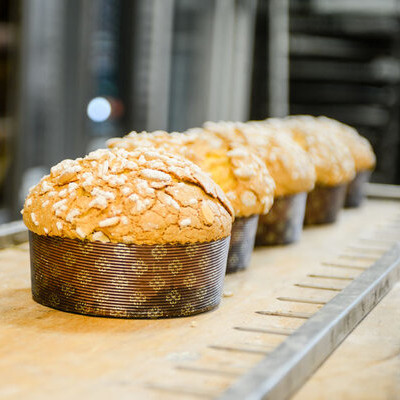
Panettone
What is Panettone?
Panettone is a type of Italian yeast-leavened cake commonly consumed at Christmas time. It has a characteristic sweet rich flavor and unique crust and crumb texture.1 Panettone can be found in two main varieties:1
- Fruit confit
- Chocolate
Origin
The earliest written mention of panettone is an Italian manuscript written in 1470 by a preceptor of the House of Sforza. The first entirely wheat flour panettone was produced in the 15th century.
In 1853, the Italian chef Giovanni Felice Luraschi wrote the New Economic Milanese Chef (Nuovo cuoco milanese economico) cookbook claiming Milan as the origin of the panettone pastry.2 Today, panettone is consumed worldwide at Chrristmas time, especially in countries with a history of italian immigration.2
Nutrition
Typical commercial chocolate and candied fruit panettone nutritional value:3,4
| Candied Fruit | Chocolate | |
|---|---|---|
| Component | % | % |
| Carbohydrate | 54 | 48 |
| Water | 23 | 24 |
| Lipids of fats | 16 | 20 |
| Protein | 7 | 8 |
Chocolate panettone provides around 400 kcal per 100 g serving, while candied fruit panettone provides 390 kcal per 100 g serving.
Commercial production
Panettone is industrially manufactured through the following process:1
Mother dough production
- First refreshment mother dough: flour (1:0.52) is added to a mix of water: flour (1:1) and is left to leaven for 4 – 6 hours at 20 – 24 oC (68 -75 oF).
- Second refreshment: flour is added to the first refreshment (1: 0.53 ratio) followed by water addition at the same ratio as first refreshment followed by leavening for 3 – 4 hours at 20 – 24 oC (68 -75 oF).
- Full sourdough: flour is added to the second refreshment (1: 0.67) and a similar ratio of water is added followed by leavening for 18 – 36 hours at 15 – 18 oC (59 -64 oF).
Cake production process
- White dough production: full sourdough is mixed in a stainless steel vessel with wheat flour, water, butter and sugar and is leavened for 6 – 8 hours at 25 – 27 oC (77 – 81 oF).
- Yellow dough production: more flour, water, sugar, butter and eggs are added to the mixture followed by a second leavening for 3 – 4 hours at 20 – 24 oC (68 -75 oF).
- Final dough: wheat flour and water are added along with raisins and candied fruits.
- Dividing: the whole dough is divided into even pieces, and are left to rise for 6 – 8 hours at 28 – 30 oC (82 -86 oF).
- Molding: the pieces are placed in paper molds for the final leavening at 30 oC (86 oF) for 6 – 8 hours.
- Baking: panettone doughs are baked at 175 – 185 oC (347 -365 oF) for 48-50 min.
- Cooling
- Packaging: each panettone is packed in a polypropylene bag and later placed in a cardboard box.
Ingredients
Panettone is commonly made with the following ingredients:1
- Water: provides moisture and aids in yeast multiplication.
- Wheat flour: provides gluten for structure and gas retention, thus aids in volume and texture.
- Eggs: give color and act as the gelling agent.
- Sugar: imparts sweetness and water holding capacity, and thus stabilization of the product.
- Butter: provides flavor, mouthfeel and texture.
- Candied fruit: provides flavor and a unique texture and is added at 20% of the dry ingredients.
- Salts: aids in leavening regulation and flavor contrast.
Regulations
Panettone doesn’t have a specific FDA regulation, however its core ingredients are considered GRAS.
Similarly in the EU, panettone doesn’t have a specific regulation and its ingredients are considered safe for consumption.
Italy is trying to add panettone to the list of products that can use protected designations, due to the cultural importance of the product, and thus amending EU Commission Regulation (EU) No 1169/2011.5
References
- Hui, Y., Corke, H., De Leyn, I., Nip, W.N and Cross, N .Bakery products: science and technology. John Wiley & Sons, 2008.
- Singer, Reid. “A Culinary History Of Panettone, The Italian And South American Christmas Treat”. Smithsonian Magazine, 2018, https://www.smithsonianmag.com/arts-culture/culinary-history-panettone-180971058/ . Accessed 12 Feb 2021.
- U.S. Department of Agriculture, Agricultural Research Service. FoodData Central, 13 July 2017. https://fdc.nal.usda.gov/fdc-app.html#/food-details/453455/nutrients . Accessed 12 February 2021.
- U.S. Department of Agriculture, Agricultural Research Service. FoodData Central, 13 January 2018. https://fdc.nal.usda.gov/fdc-app.html#/food-details/516338/nutrients . Accessed 12 February 2021.
- “Notification Detail:Draft Ministerial Decree On Amending The Ministerial Decree Of 22 July 2005 For Governing The Production And Sale Of Certain Bakery Products.”. Ec.Europa.Eu, 2021, https://ec.europa.eu/growth/tools-databases/tris/en/index.cfm/search/?trisaction=search.detail&year=2016&num=412&mLang=en&CFID=30969068&CFTOKEN=26687227 . Accessed 12 Feb 2021.

